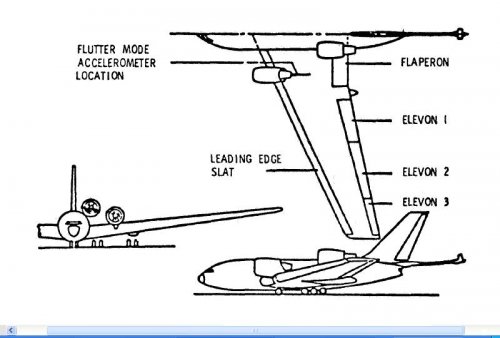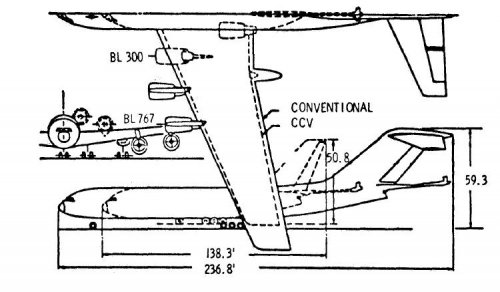In an Air Force sponsored study, conducted by the Boeing Company, a control configured vehicle (CCV) tanker aircraft was designed to satisfy the same mission requirements specified for an advanced conventional tanker.
General Characteristics
Wing span (ft): 251
Fuselage Length (ft): 125
Fuselage maximum diameter (ft): 18
Design weight (lb): 835,900
Cruise speed: .75 Mach
Payload: 348,900 pounds of fuel off-loaded at 30,000 feet at .68 Mach
Three-view drawing (top) of Boeing CCV tanker point design labelled BL-300. Note the lack of horizontal tail.
Comparison drawing (bottom) of Boeing BL-300 with an advanced conventional tanker design BL-767.
Source:
Walker, S. A. Design of a Control Configured Tanker Aircraft Aeronautical Systems Division, Wright-Paterson Air Force Base August 1, 1976
Abstract:
 ntrs.nasa.gov
ntrs.nasa.gov
General Characteristics
Wing span (ft): 251
Fuselage Length (ft): 125
Fuselage maximum diameter (ft): 18
Design weight (lb): 835,900
Cruise speed: .75 Mach
Payload: 348,900 pounds of fuel off-loaded at 30,000 feet at .68 Mach
Three-view drawing (top) of Boeing CCV tanker point design labelled BL-300. Note the lack of horizontal tail.
Comparison drawing (bottom) of Boeing BL-300 with an advanced conventional tanker design BL-767.
Source:
Walker, S. A. Design of a Control Configured Tanker Aircraft Aeronautical Systems Division, Wright-Paterson Air Force Base August 1, 1976
Abstract:
The benefits that accrue from using control configured vehicle (CCV) concepts were examined along with the techniques for applying these concepts to an advanced tanker aircraft design. Reduced static stability (RSS) and flutter mode control (FMC) were the two primary CCV concepts used in the design. The CCV tanker was designed to the same mission requirements specified for a conventional tanker design. A seven degree of freedom mathematical model of the flexible aircraft was derived and used to synthesize a lateral stability augmentation system (SAS), a longitudinal control augmentation system (CAS), and a FMC system. Fatigue life and cost analyses followed the control system synthesis, after which a comparative evaluation of the CCV and conventional tankers was made. This comparison indicated that the CCV weight and cost were lower but that, for this design iteration, the CCV fatigue life was shorter. Also, the CCV crew station acceleration was lower, but the acceleration at the boom operator station was higher relative to the corresponding conventional tanker. Comparison of the design processes used in the CCV and conventional design studies revealed that they were basically the same.
Design of a control configured tanker aircraft - NASA Technical Reports Server (NTRS)
The benefits that accrue from using control configured vehicle (CCV) concepts were examined along with the techniques for applying these concepts to an advanced tanker aircraft design. Reduced static stability (RSS) and flutter mode control (FMC) were the two primary CCV concepts used in the...
Attachments
Last edited by a moderator:


